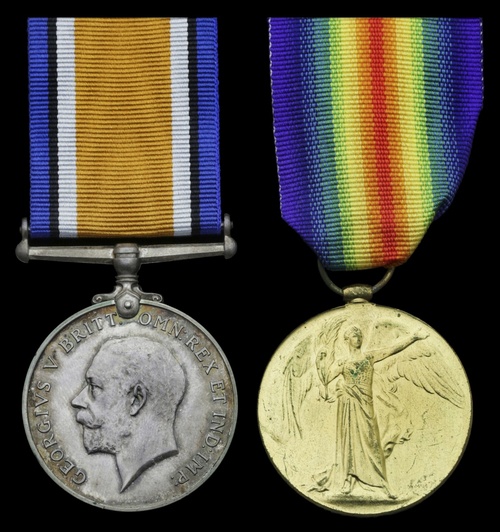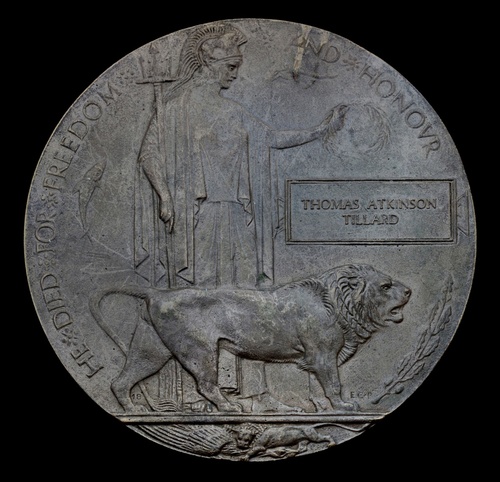Auction: 20002 - Orders, Decorations, Medals & Space Exploration
Lot: 337
A Great War Pilot casualties group of three awarded to Flight Lieutenant T. A. Tillard, No. 1 Squadron, Royal Flying Corps, late Norfolk Yeomanry and Middlesex Regiment, who lost control of his two-seat Morane Scout and nose-dived from 5000 feet into the ground near Abeele Aerodrome whilst practising co-operation with the infantry; the force of the impact was sufficient to drive the engine into the passenger's seat
British War and Victory Medals (Capt. T. A. Tillard), together with his bronze Memorial Plaque (Thomas Atkinson Tillard) nearly extremely fine (3)
Thomas Atkinson Tillard was born on 25 February 1884 at Baltimore, Maryland, USA, the younger son of Algernon Tillard and Mrs. Bonham-Carter of Adhurst St. Mary, Petersfield, Hampshire. Educated at Eton College and Cambridge University, he graduated with a Bachelor of Arts in 1906 and a small wrap on the knuckles from the Cambridge Police Court having obstructed a footpath with his bicycle. Stating that he thought the police officer who found it 'might have taken it to Trinity College, as his name and address was on the saddle bag', the court clearly felt the defendant was being a little difficult. He was fined 5 shillings when similar offences brought before the Court that day afforded fines of 2s. 6d. (The Cambridge Independent Press, 9 June 1905, refers).
Employed in Sudan as a civil engineer specialising in hydraulics and irrigation, Tillard became a wealthy young man when he was bequeathed £10,000 by his stepfather, Mr. John Bonham-Carter, who passed away on 21 December 1905 leaving an estate of £267,400 0s. 8d. (The Evening News, refers). The generous gentleman left considerable property at Buriton, near Petersfield, together with an impressive townhouse at 17, Chesham Street, London.
At the outbreak of the hostilities, Tillard initially attested for the Middlesex Regiment as a Private. Commissioned into the Norfolk Yeomanry on 10 November 1914, he transferred to the Royal Flying Corps and was gazetted Flying Officer in March 1916. He then trained as a Pilot at Norwich, being sent to France and attached to No. 3 Squadron, Royal Flying Corps, from 6 April 1916. Exactly three months later he was wounded in action and sent to hospital, reputedly in consequence of receiving a bullet wound to the leg. Recovered, Tillard returned to the skies above the Western Front with No. 34 Squadron and was promoted Flight Commander on 3 November 1916, before successfully returning to his former Squadron under the command of Major David E. Stodart, D.S.O., D.F.C., which was licking its wounds following extensive action over the Somme battlefield.
Having been relatively fortunate and escaped serious harm in comparison to many of his contemporaries and the infantry which were slogging it out in a game of stalemate below, Tillard's luck finally ran out in consequence of an unlikely flying accident whilst practising infantry co-operation (The Record Book of No. 1 Squadron, R.F.C., refers). Transferred to No. 1 Squadron just seven days before, Tillard and Lieutenant G. Murdoch were killed on 6 December 1916 when Moraine P.5175 crashed near Meterin. The circumstances of his death were later recorded by Charles R. Main, who was able to relay an eye-witness account of his final moments by Captain Bettinger:
'He was out testing a Morane (which is a machine on which it is not safe to take any chances) and apparently without warning he lost control and the machine nose-dived to earth from about five thousand feet. Poor old Tom was killed instantly, the engine being driven right back as far as the passenger's seat.
He had a trick of throttling down his engine until the wind just supported him, or so that he was not moving relative to the ground, and so it is quite conceivable that if the wind velocity was below the flying speed (minimum) of the machine it would be unstable and loss of control result, and being at a low altitude, he was not able to regain control. He did some very good work on the Flying Corps and was universally liked, his men seemed to be particularly fond of him and there were few sorrier to hear of his death than I' (An extract from 'Technology Review', M.I.T., November 1918, refers).
He is buried in Bailleul Military Cemetery Extension near the Belgian border. Thomas A. Tillard and his brother, Philip Algernon Tillard - who was killed in action at the Battle of the Ancre on 18 November 1916 whilst serving with the 8th Battalion, East Surrey Regiment - are further commemorated upon an impressive brass plaque mounted on the wall of St Mary Magdalen Church in Sheet, Hampshire. The final poignant words note:
'Loved and pleasant were they in their lives and in death they were not divided.'
Sold with copied research and a compact disc offering details regarding the life of Thomas A. Tillard.
Subject to 20% VAT on Buyer’s Premium. For more information please view Terms and Conditions for Buyers.
Sold for
£950
Starting price
£320







